I used a linked caterpillar set sold separately for AFV Club Tiger I. Built in March 2015.
 At this moment, it’s an ancient kit; it was released around 2005. I began to make this Tiger I tank. Because this kit was stocked for around four years, I thought it would be completed. I made a similar Dragon Models kit around six years ago.
At this moment, it’s an ancient kit; it was released around 2005. I began to make this Tiger I tank. Because this kit was stocked for around four years, I thought it would be completed. I made a similar Dragon Models kit around six years ago.
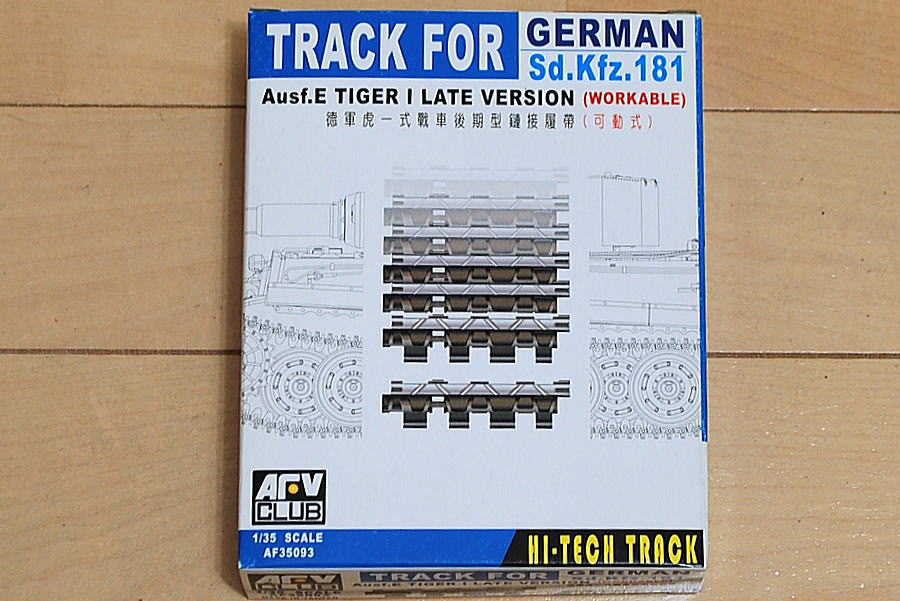 I excavated such a thing from the closet’s depths. 2 sets of late-type caterpillars and two more sets of early-type. Maybe I bought them in the stage of the exchange rate in favor of the yen strong but almost forgot it. Tiger I is also released from Zvezda and Tamiya. I’ll have a chance to use them near future.
I excavated such a thing from the closet’s depths. 2 sets of late-type caterpillars and two more sets of early-type. Maybe I bought them in the stage of the exchange rate in favor of the yen strong but almost forgot it. Tiger I is also released from Zvezda and Tamiya. I’ll have a chance to use them near future.
 The total parts are fewer than the Dragon Models kit I made many times. Having a careful-looking belt caterpillar mold is very good.
The total parts are fewer than the Dragon Models kit I made many times. Having a careful-looking belt caterpillar mold is very good.
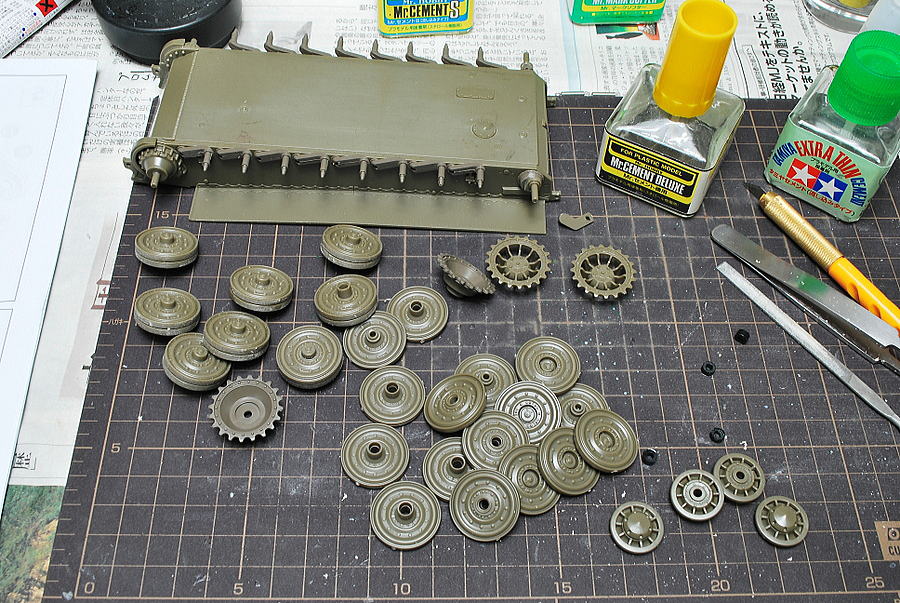 Many road wheels, I’m used to making many wheels and fast working. In this kit, all wheels are required to be set in polyester caps.
Many road wheels, I’m used to making many wheels and fast working. In this kit, all wheels are required to be set in polyester caps.
 It’s late-type; I may not exclude Zimmerit Coating. I prepared Tamiya and Wave epoxy putty. Because I attach parts immediately after coating, I assemble mufflers and other parts beforehand. The Tamiya epoxy putty hardening time is 12 hours; Wave is 2 hours.
It’s late-type; I may not exclude Zimmerit Coating. I prepared Tamiya and Wave epoxy putty. Because I attach parts immediately after coating, I assemble mufflers and other parts beforehand. The Tamiya epoxy putty hardening time is 12 hours; Wave is 2 hours.
(30-January-2015)
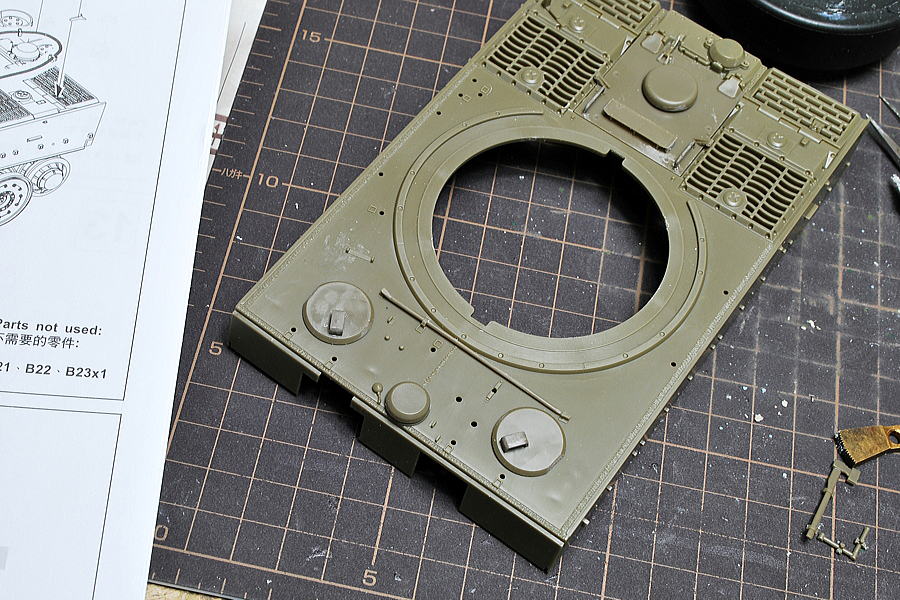 These clamp handles are molded on the body, and other clamp parts are molded on the OVM parts. I think such a method effectively avoids struggling with many very detailed etchings.
These clamp handles are molded on the body, and other clamp parts are molded on the OVM parts. I think such a method effectively avoids struggling with many very detailed etchings.
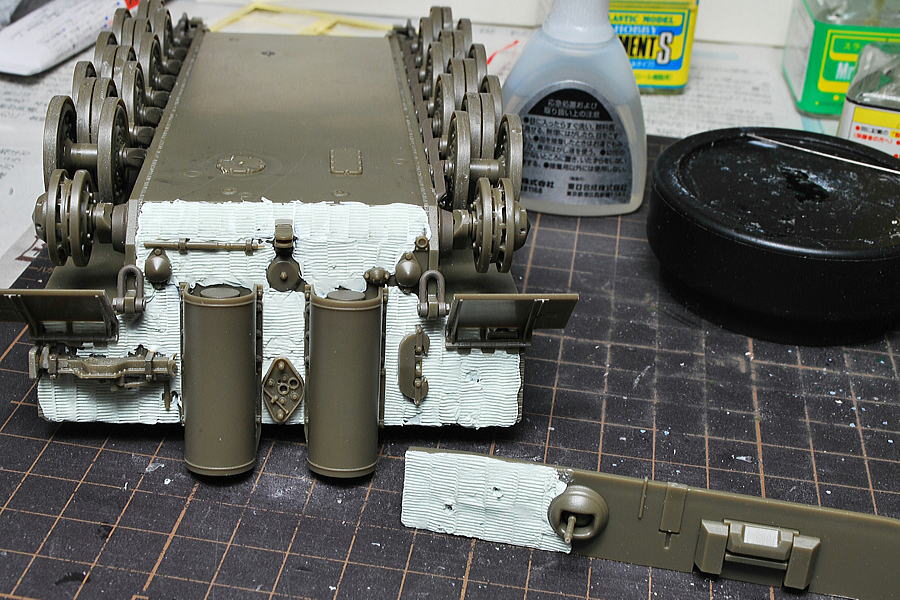 I checked the road wheels straight from the lengthwise direction. And while covering the rear armor over this putty, I attached many parts at the same time quickly. This Tamiya putty has 12 hours to fix. I could go shopping. On this front armor, I made some battle damage.
I checked the road wheels straight from the lengthwise direction. And while covering the rear armor over this putty, I attached many parts at the same time quickly. This Tamiya putty has 12 hours to fix. I could go shopping. On this front armor, I made some battle damage.
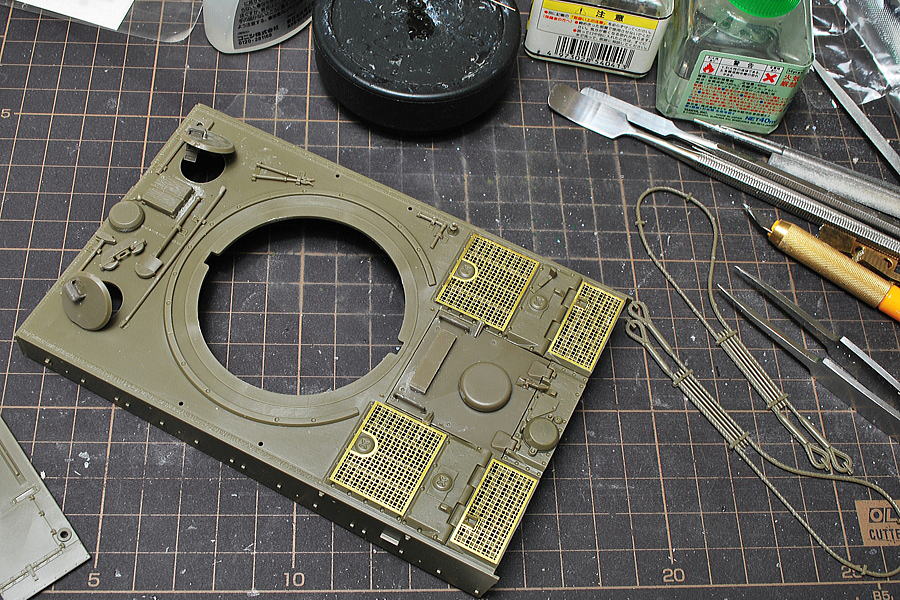 In this kit, very few photo-etched parts, but effective. Nice engine covers attract detailed appeal.
In this kit, very few photo-etched parts, but effective. Nice engine covers attract detailed appeal.
(11-February-2015)
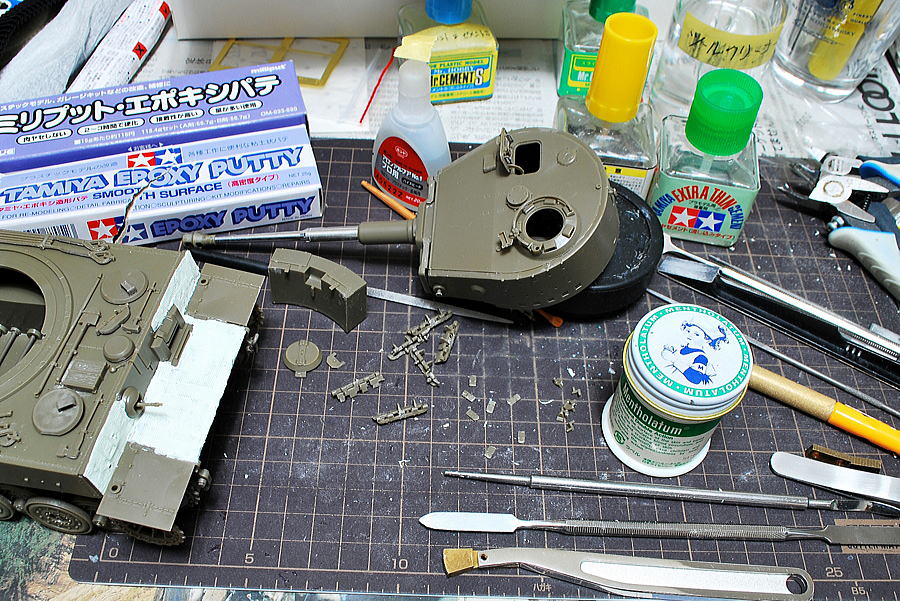 I returned to this coating work. I used a skin cream like Mentholatum to prevent putty sticks to the roller too much.
I returned to this coating work. I used a skin cream like Mentholatum to prevent putty sticks to the roller too much.
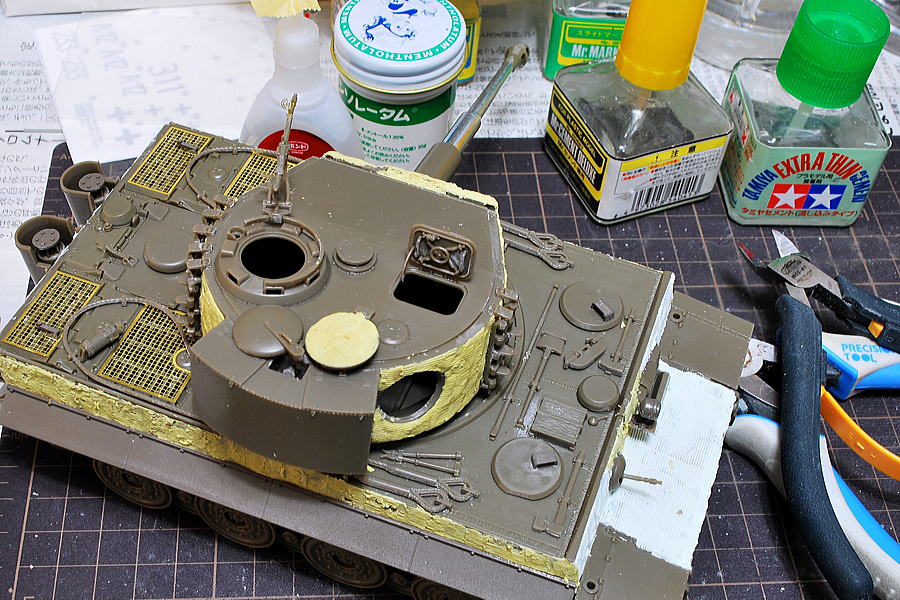 I thought the coating came off here, and there looks like a used vehicle. I damaged the armor moderately. I trimmed the end of the round hatch neatly.
I thought the coating came off here, and there looks like a used vehicle. I damaged the armor moderately. I trimmed the end of the round hatch neatly.
 The belt caterpillar looks not bad, with detailed mold and fitting with wheels. I wonder if this belt is adhesive to ordinary plastic cement.
The belt caterpillar looks not bad, with detailed mold and fitting with wheels. I wonder if this belt is adhesive to ordinary plastic cement.
 Here’s connecting movable caterpillar. Even one side is very long; I use the A4-sized cutter mat to the full diagonally, but it still seems insufficient.
Here’s connecting movable caterpillar. Even one side is very long; I use the A4-sized cutter mat to the full diagonally, but it still seems insufficient.
It’s Valentine’s Day today in Japan, and it’s the day that a girlfriend (lady) buys chocolate for a boyfriend (man); I am told that cake companies decide it. My wife bought cakes, so today’s work is ended…
(14-February-2015)
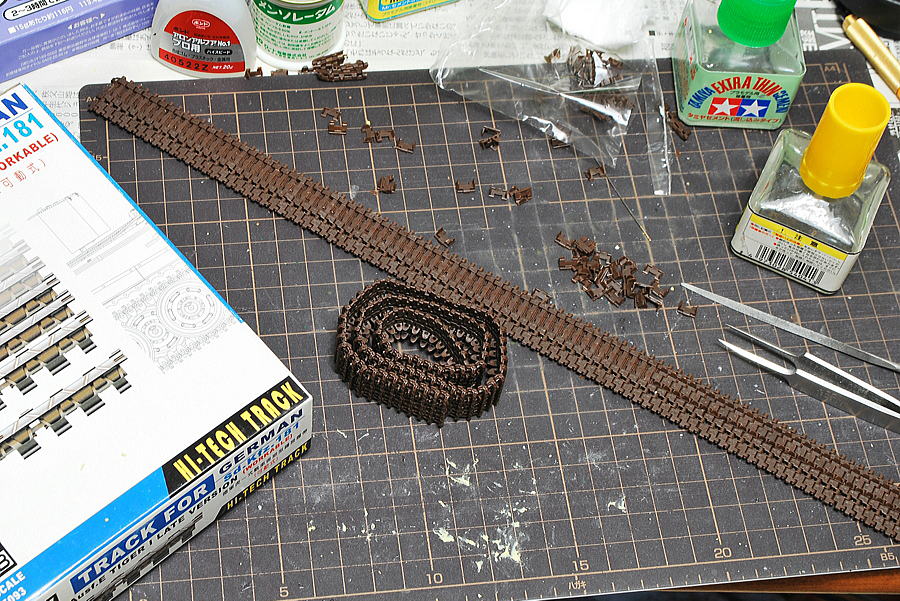 The assembling is not tricky. It is movable; I can round it like in the photo. I finally adhered it all with glue, but it’s significant merit to be easy to make fine adjustments of the caterpillar.
The assembling is not tricky. It is movable; I can round it like in the photo. I finally adhered it all with glue, but it’s significant merit to be easy to make fine adjustments of the caterpillar.
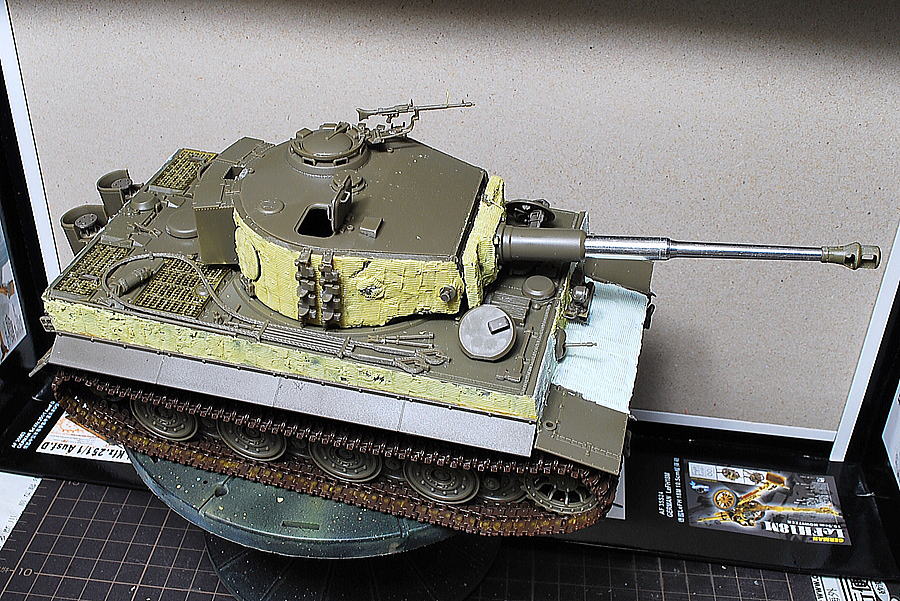 The assembling of the turret was complicated. The left and right turret parts were a bit of deformation, so I combined them using plastic glue and instant glue.
The assembling of the turret was complicated. The left and right turret parts were a bit of deformation, so I combined them using plastic glue and instant glue.
 I buried the injection pin marks of the caterpillar in Tamiya light-curing putty. This putty’s plastic cap was broken by age deterioration. The second of this was broken on the way, too. It is a feeling to be broken at times fixed like a timer and to promote the subsequent demand… I think this cap should be replaced with a metal cap. Or I hope Tamiya releases the adjusted metal cap by selling separately for a small price.
I buried the injection pin marks of the caterpillar in Tamiya light-curing putty. This putty’s plastic cap was broken by age deterioration. The second of this was broken on the way, too. It is a feeling to be broken at times fixed like a timer and to promote the subsequent demand… I think this cap should be replaced with a metal cap. Or I hope Tamiya releases the adjusted metal cap by selling separately for a small price.
 My forefinger got hurt a little by my nipper. It’s difficult to assemble even its small wound. I use Band-Aid, but the instant glue may help close my wound unexpectedly early.
My forefinger got hurt a little by my nipper. It’s difficult to assemble even its small wound. I use Band-Aid, but the instant glue may help close my wound unexpectedly early.
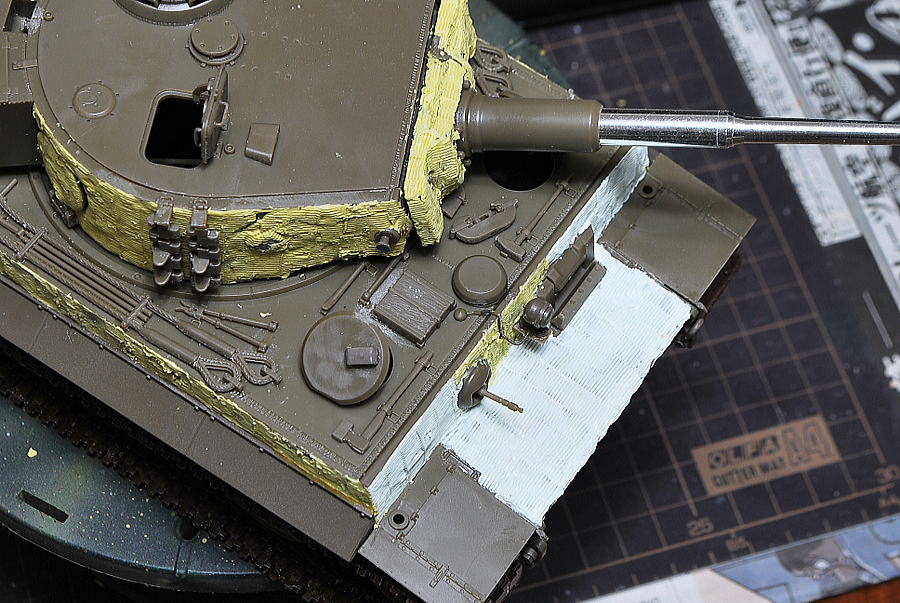 I ran out of Tamiya putty on the way; I used Wave and Tamiya together. Tamiya is sticky, easy to attach to plastic surfaces, excellent, and to shape with my spatula, but it isn’t easy to scratch or peel off from the plastic plate.
I ran out of Tamiya putty on the way; I used Wave and Tamiya together. Tamiya is sticky, easy to attach to plastic surfaces, excellent, and to shape with my spatula, but it isn’t easy to scratch or peel off from the plastic plate.
 As for the Wave putty, it’s dry and hard to attach to the plastic. It’s suitable to express peeling off the Zimmerit Coating with a design knife. Wave putty starts hardening in an hour, so I recommend you mix the putty little by little.
As for the Wave putty, it’s dry and hard to attach to the plastic. It’s suitable to express peeling off the Zimmerit Coating with a design knife. Wave putty starts hardening in an hour, so I recommend you mix the putty little by little.
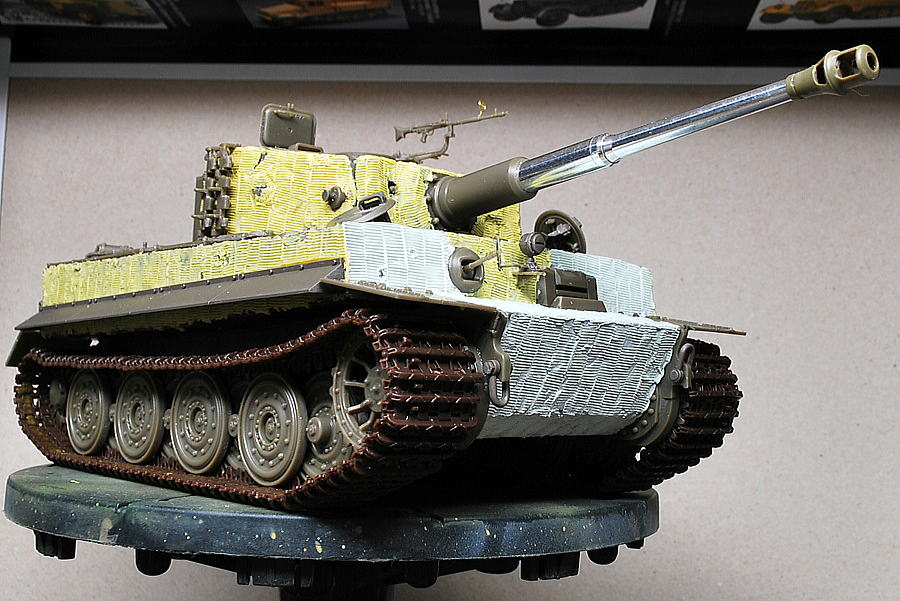 I wrote that I used Mentholatum on the above, but I think water is possible to use. But this Wave putty is soluble in water so should be careful.
I wrote that I used Mentholatum on the above, but I think water is possible to use. But this Wave putty is soluble in water so should be careful.
 I thought it was the right feeling that the coating came off here and there but was slightly too rough. Anyway, I paint the peel-off area dark brown.
I thought it was the right feeling that the coating came off here and there but was slightly too rough. Anyway, I paint the peel-off area dark brown.
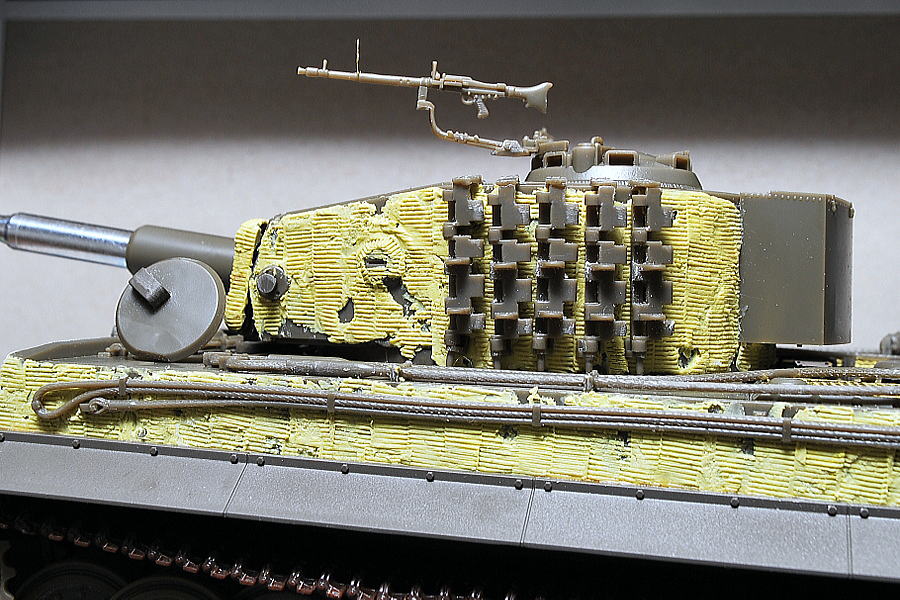 I checked the place with the art box and have a tidy layout as I can. The spare caterpillar attaching mark molded on the turret was buried in putty. Some are twisted; maybe it’s battle damage…
I checked the place with the art box and have a tidy layout as I can. The spare caterpillar attaching mark molded on the turret was buried in putty. Some are twisted; maybe it’s battle damage…
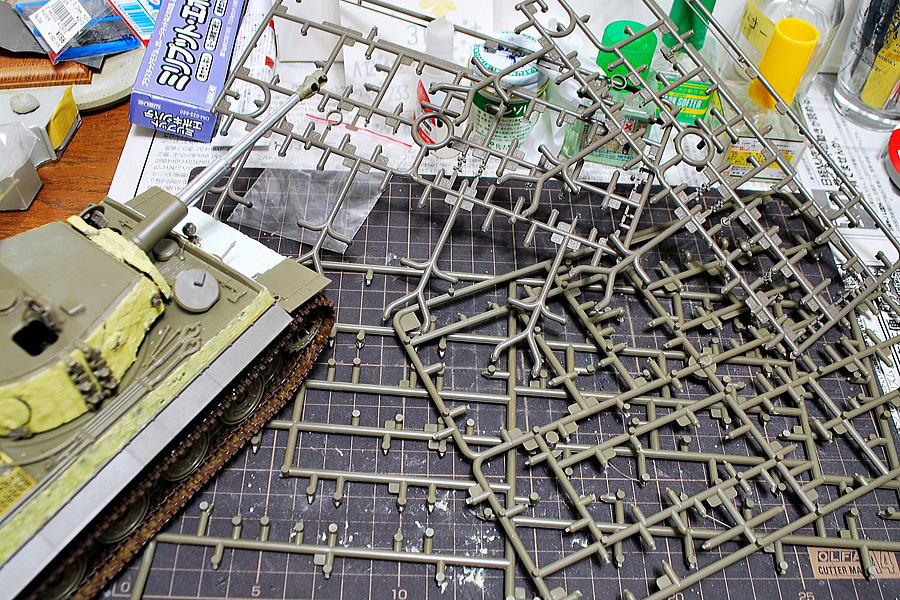 Compared with the Dragon kit I used to make, this AFV Club kit doesn’t have any remaining parts in the runner. The next step is to start painting.
Compared with the Dragon kit I used to make, this AFV Club kit doesn’t have any remaining parts in the runner. The next step is to start painting.
(22-February-2015)
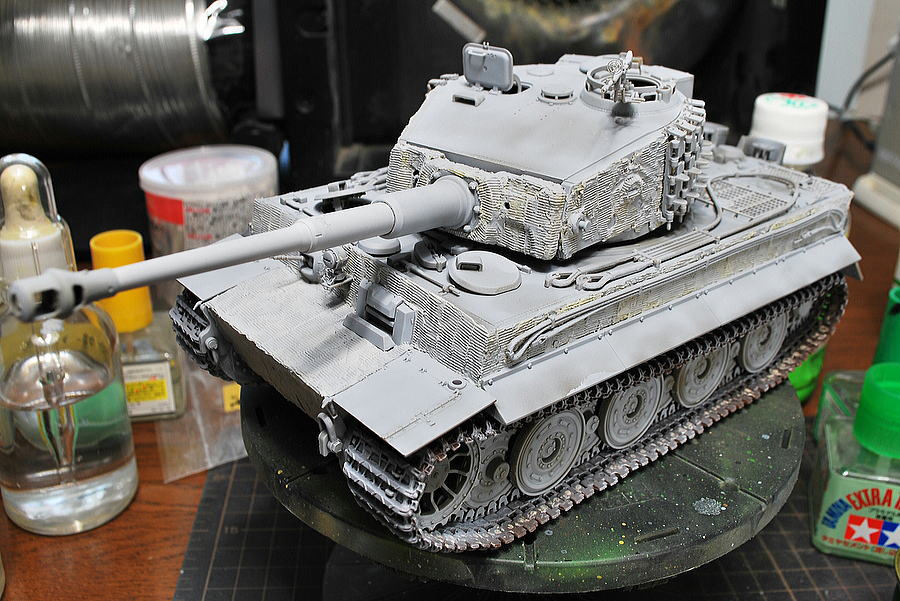 Recently I didn’t use the surfacer before painting, but I used it this time as the multi-material colored body is not working well on the dark yellow.
Recently I didn’t use the surfacer before painting, but I used it this time as the multi-material colored body is not working well on the dark yellow.
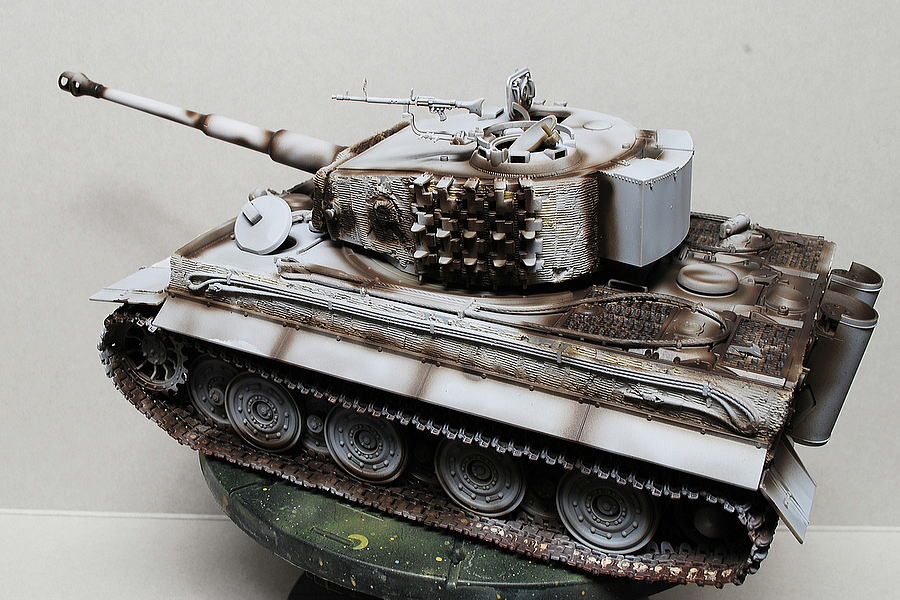 I painted the shadow area dark brown.
I painted the shadow area dark brown.
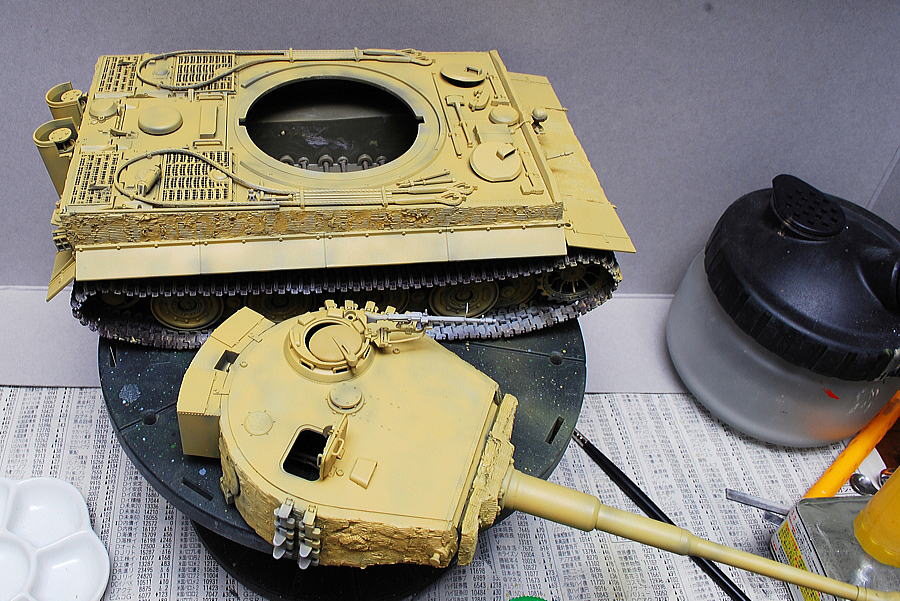 Very slightly remaining dark brown and painted base color dark yellow.
Very slightly remaining dark brown and painted base color dark yellow.
 I thought the primary color should be dark green, extensive to give the atmosphere of the German military tank of the last years of WWII, but this photo is also OK, I suppose.
I thought the primary color should be dark green, extensive to give the atmosphere of the German military tank of the last years of WWII, but this photo is also OK, I suppose.
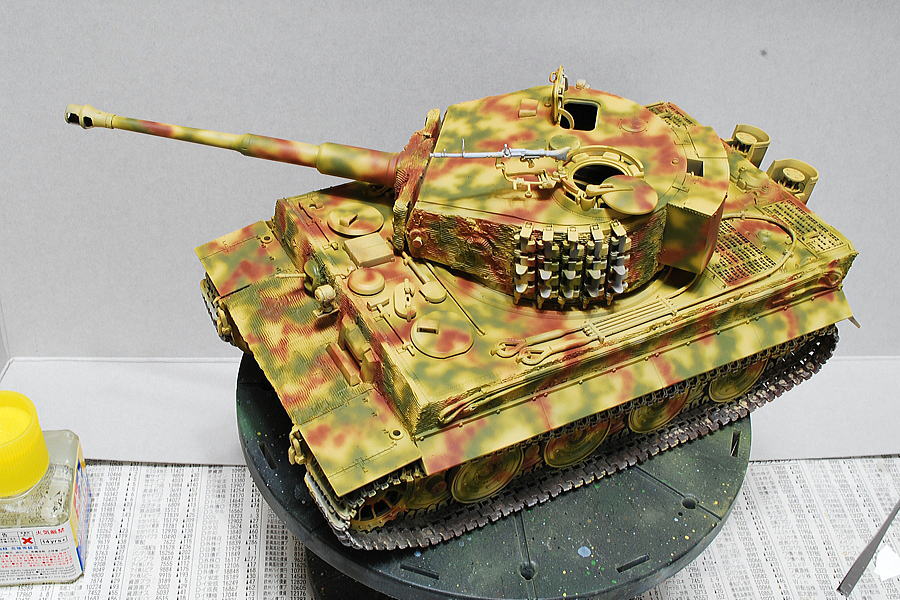 I might be finished with the three-color camouflage of the considerably complicated random pattern. I adjusted the color tone a little to mix dark yellow into dark green and red-brown, and the united feeling of the overall tone appeared. When the camouflage paint is over, I felt accomplishment feeling.
I might be finished with the three-color camouflage of the considerably complicated random pattern. I adjusted the color tone a little to mix dark yellow into dark green and red-brown, and the united feeling of the overall tone appeared. When the camouflage paint is over, I felt accomplishment feeling.
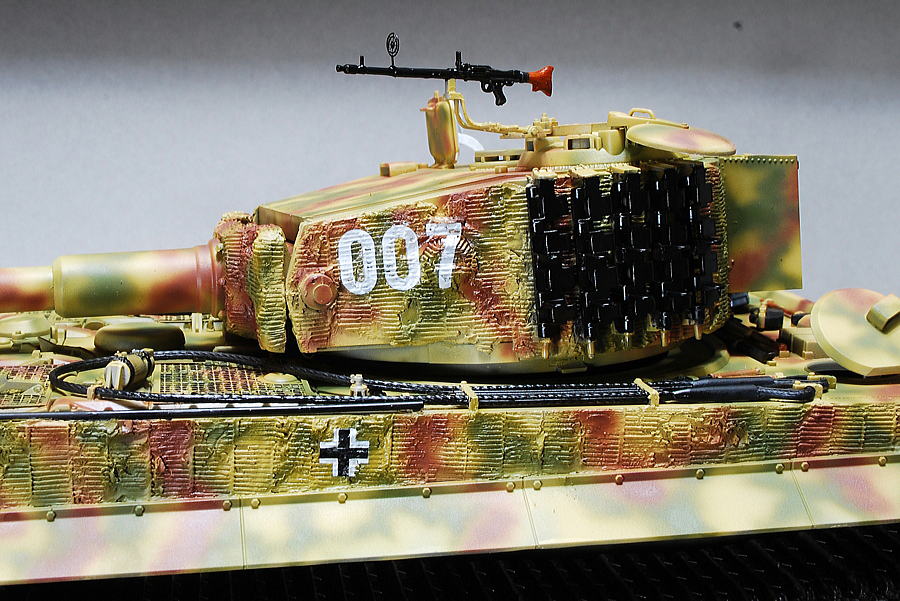 Finally, I used plastic cement on this decal, and anyway, it’s attached. This attached decal was not softened on the rough coating, unlike Cartograf decals, even though I used decals softer. Some parts are melted, so I must retouch them with a brush.
Finally, I used plastic cement on this decal, and anyway, it’s attached. This attached decal was not softened on the rough coating, unlike Cartograf decals, even though I used decals softer. Some parts are melted, so I must retouch them with a brush.
(28-February-2015)
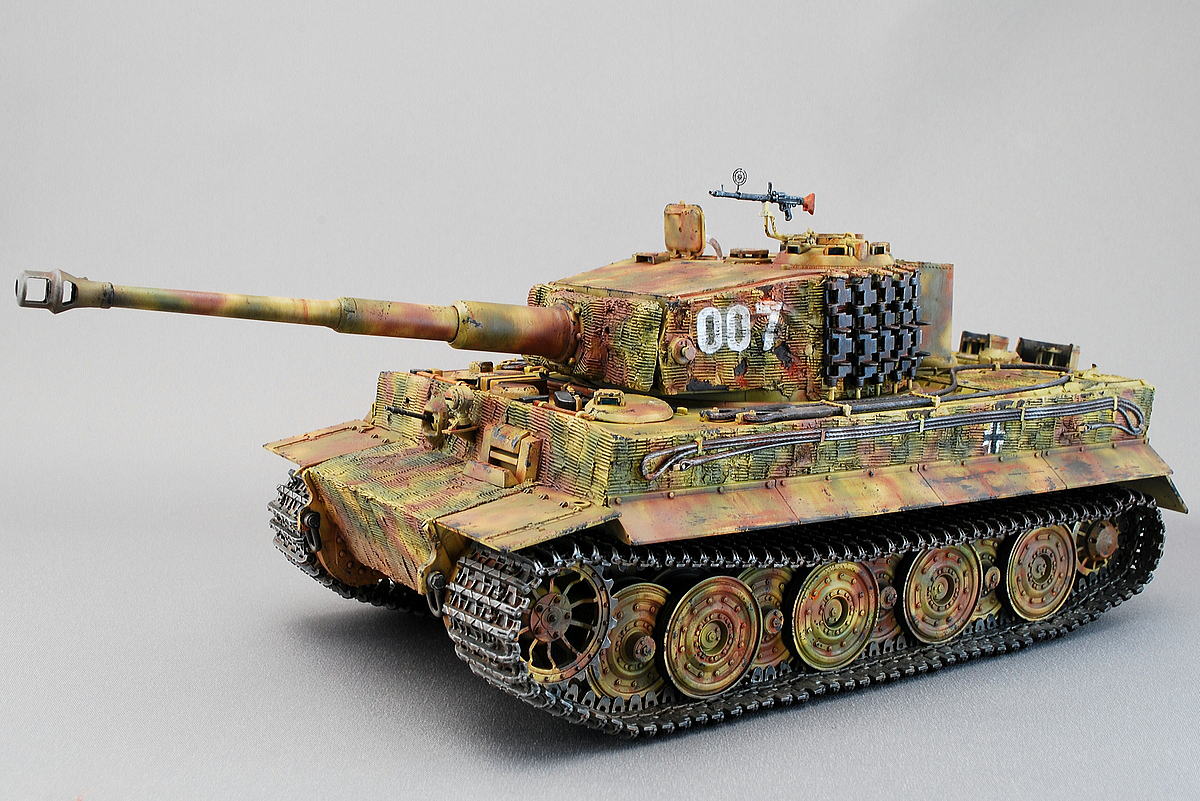 I just completed the AFV Club Tiger I latest type. The marking is Waffen SS 101st Heavy Panzer Battalion in Cean, France, in 1944. It is around the time of a famous fight, the Battle of Villers-Bocage.
I just completed the AFV Club Tiger I latest type. The marking is Waffen SS 101st Heavy Panzer Battalion in Cean, France, in 1944. It is around the time of a famous fight, the Battle of Villers-Bocage.
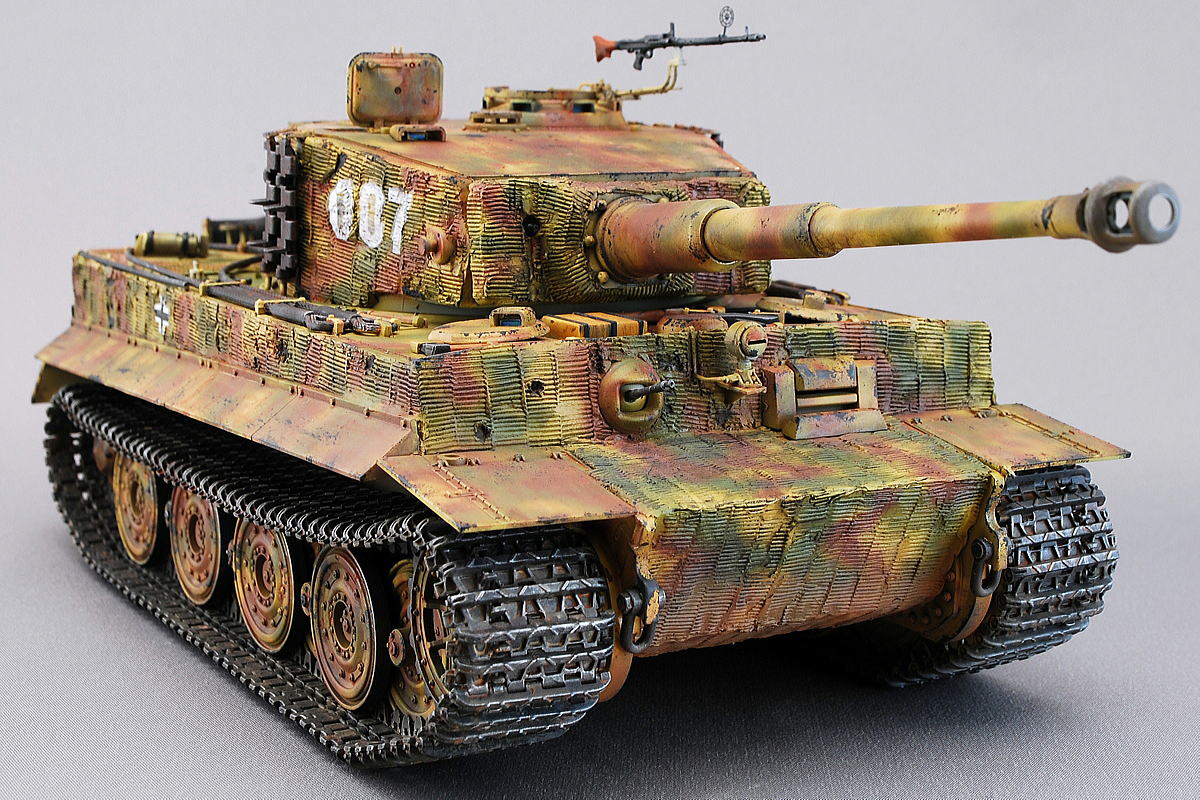 In the first place, was it good for the latest model to do coating? Anyway, this time the coated tank is better looking. The latest model’s characteristic points are the hinge of the escape hatch on the turret, the backside of the loader’s hatch, the size of the idler wheels, the muzzle brake, etc., suitable.
In the first place, was it good for the latest model to do coating? Anyway, this time the coated tank is better looking. The latest model’s characteristic points are the hinge of the escape hatch on the turret, the backside of the loader’s hatch, the size of the idler wheels, the muzzle brake, etc., suitable.
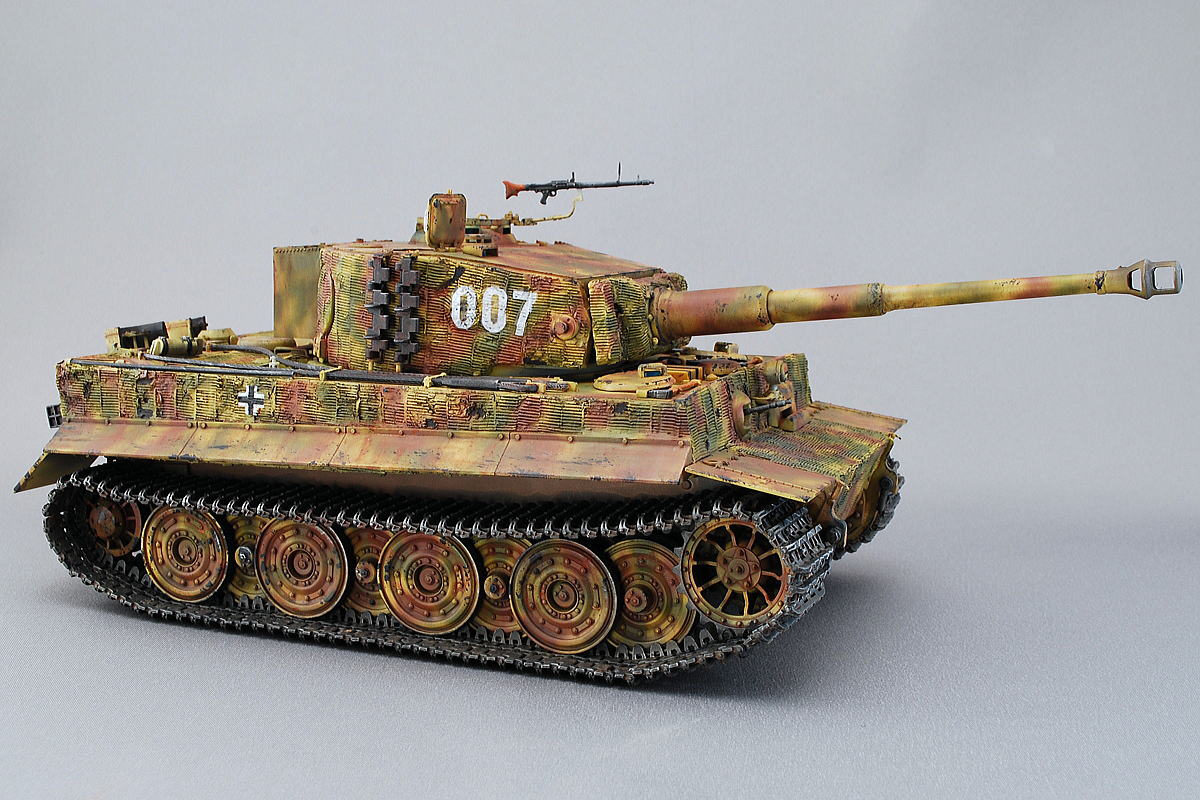 I did washing strongly and emphasized the mold of Zimmerit Coating.
I did washing strongly and emphasized the mold of Zimmerit Coating.
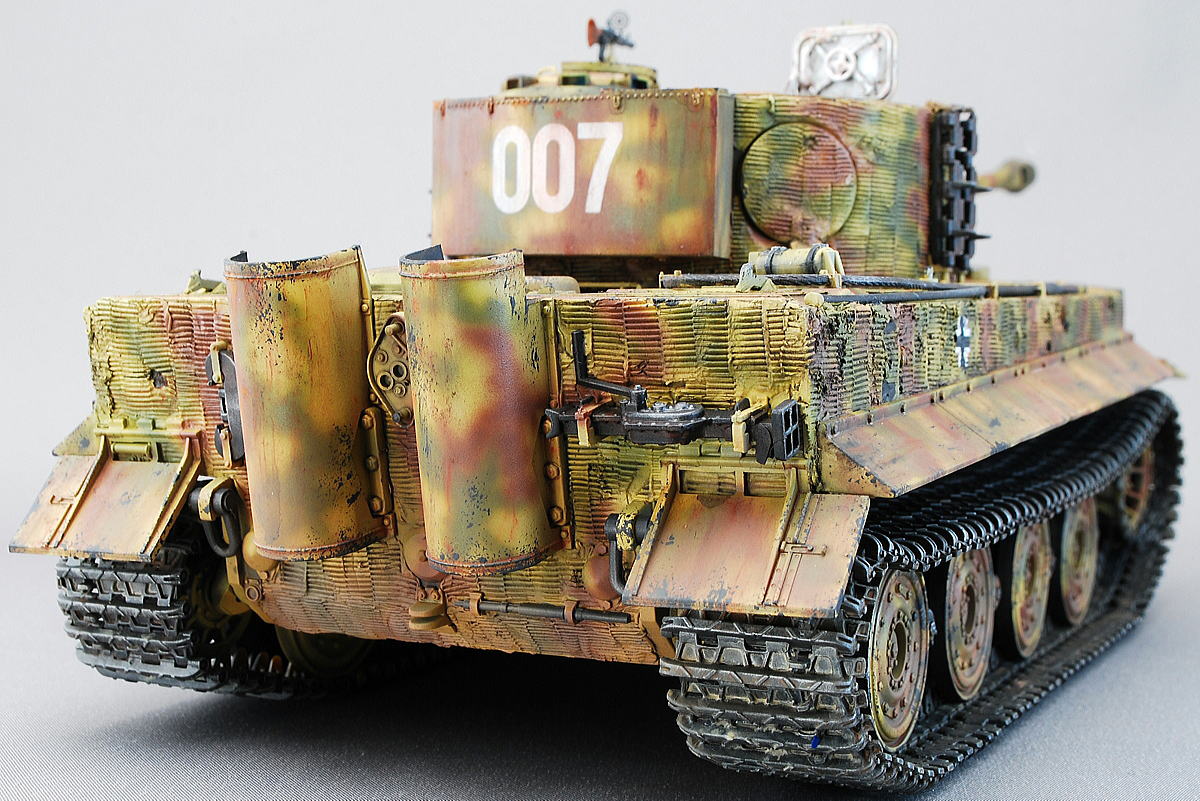 Back in this tank, I didn’t wipe the paint after washing to express patterns of rain marks.
Back in this tank, I didn’t wipe the paint after washing to express patterns of rain marks.
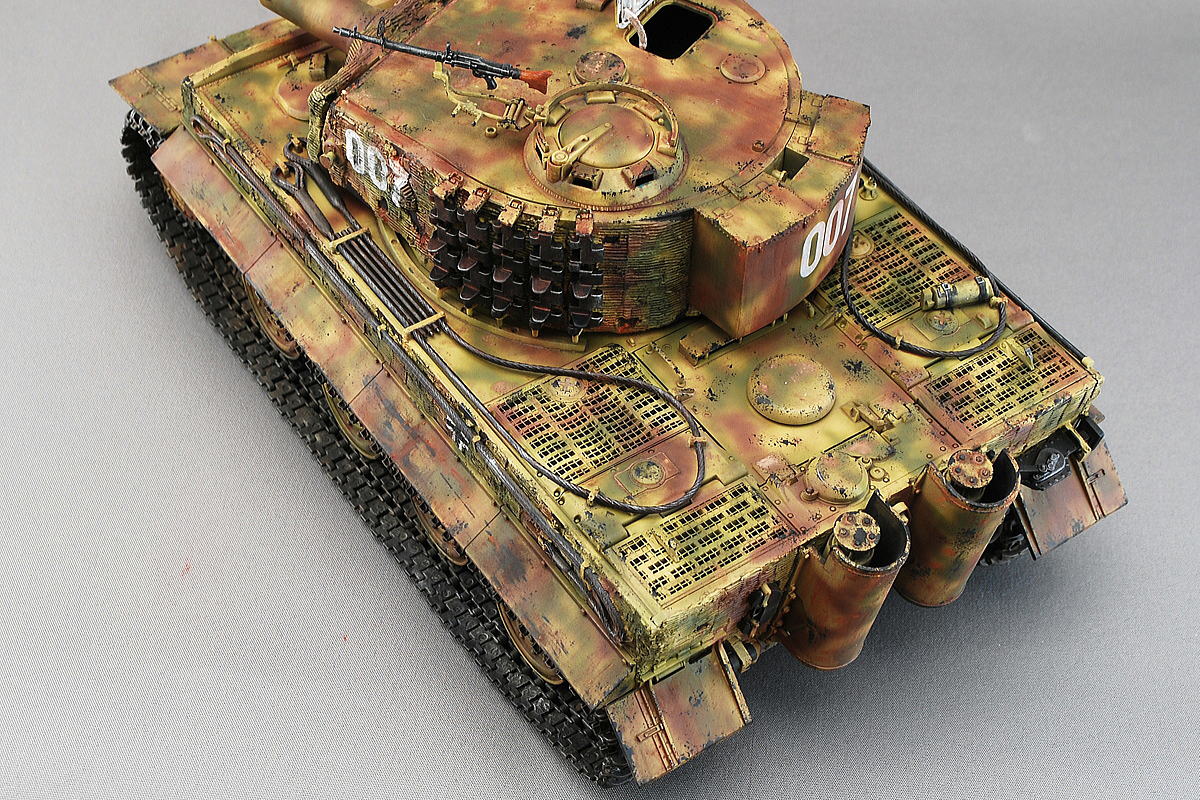 The last stage of the WWII German tank camouflage pattern has the largest area color, dark green. I have another heavy tank of King Tiger Henschel gun turret, and I’ll try this tank blow first green. Maybe it’s more interesting to blow first dark green.
The last stage of the WWII German tank camouflage pattern has the largest area color, dark green. I have another heavy tank of King Tiger Henschel gun turret, and I’ll try this tank blow first green. Maybe it’s more interesting to blow first dark green.
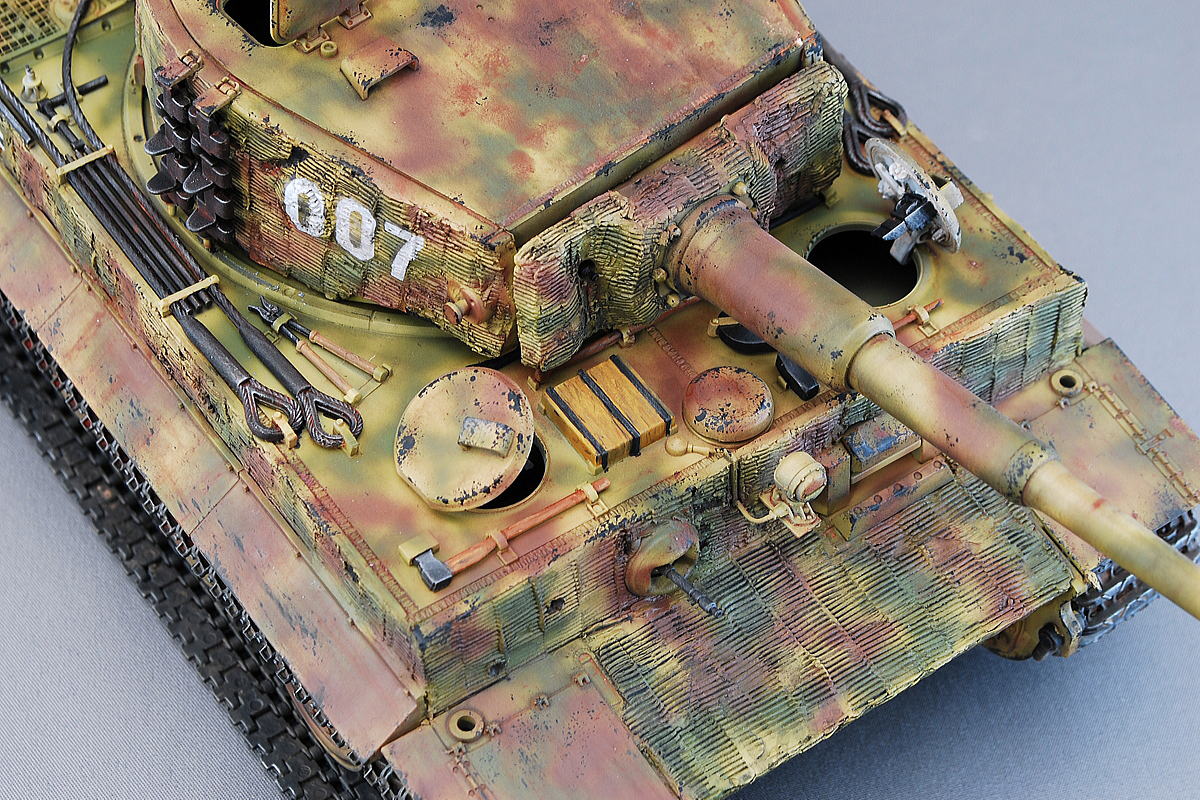 Many items should be painted black as spare caterpillar tracks, wire ropes, and hard-working handwriting brushes. This time I cared to paint woody parts of wood texture.
Many items should be painted black as spare caterpillar tracks, wire ropes, and hard-working handwriting brushes. This time I cared to paint woody parts of wood texture.
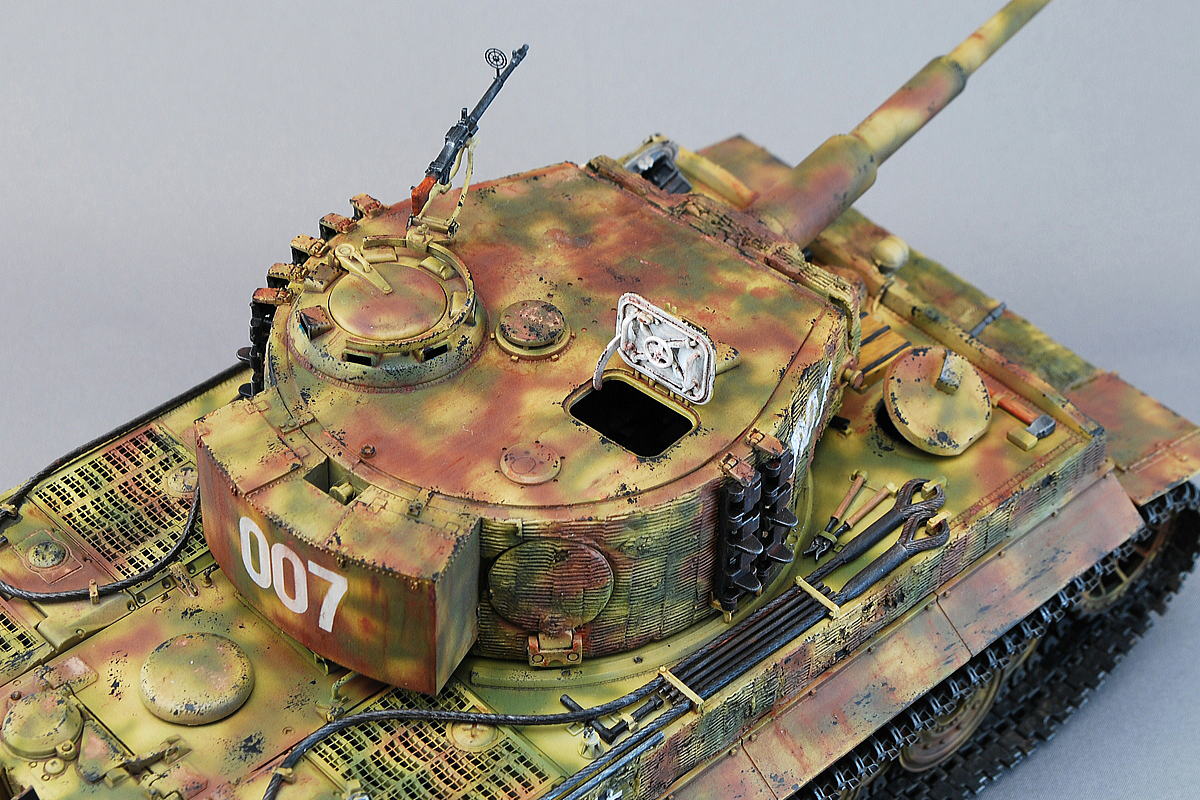 I draw rain and scratch marks while running parallel to the ground.
I draw rain and scratch marks while running parallel to the ground.
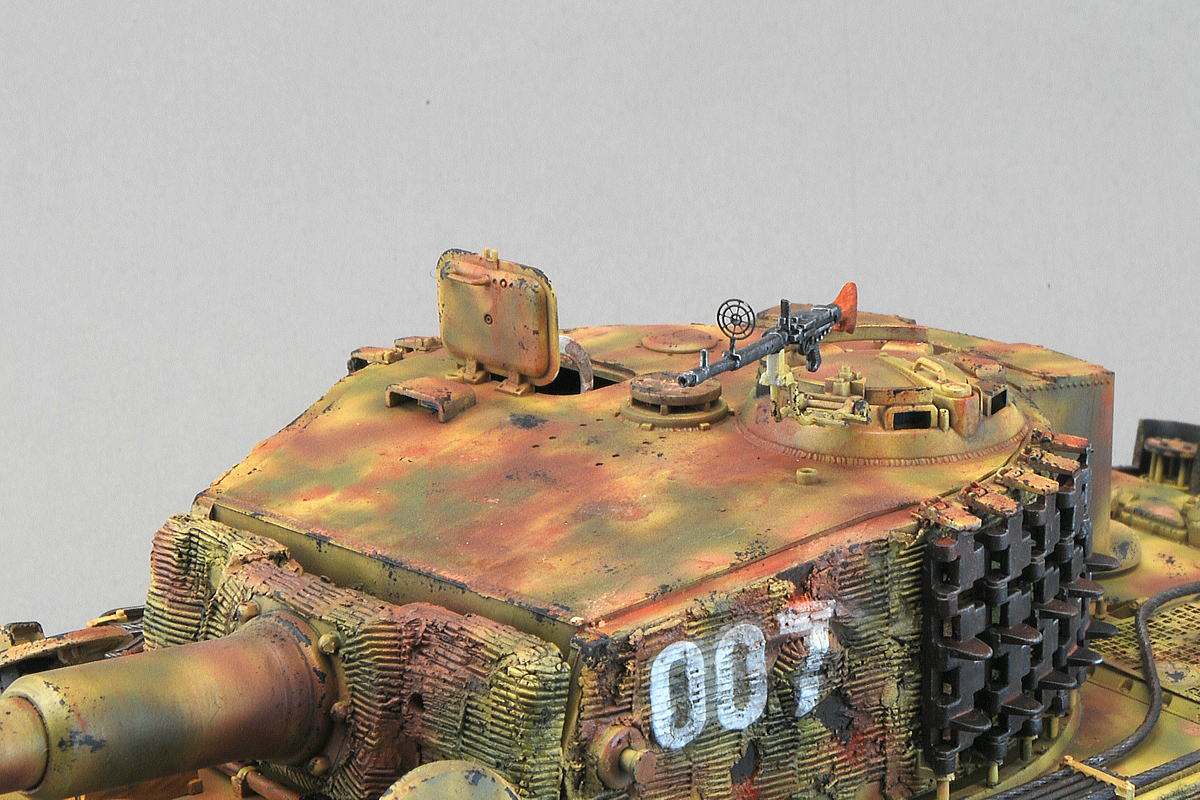 Mounted machine-gun aiming is a good accent of detail. I can see it from every angle.
Mounted machine-gun aiming is a good accent of detail. I can see it from every angle.
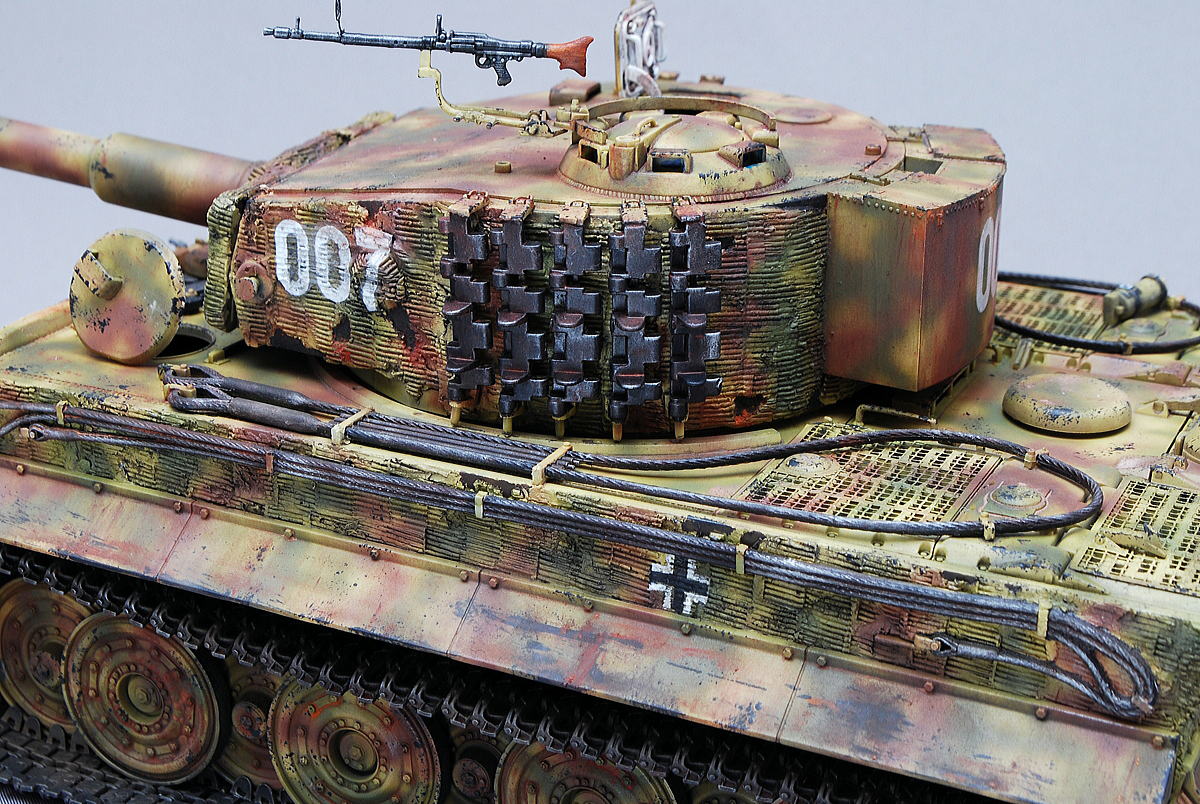 Wire ropes are plastic parts. I have a mind to paint the wires like metallic texture. Of course, the metal wire is better, but this part is almost OK for me.
Wire ropes are plastic parts. I have a mind to paint the wires like metallic texture. Of course, the metal wire is better, but this part is almost OK for me.
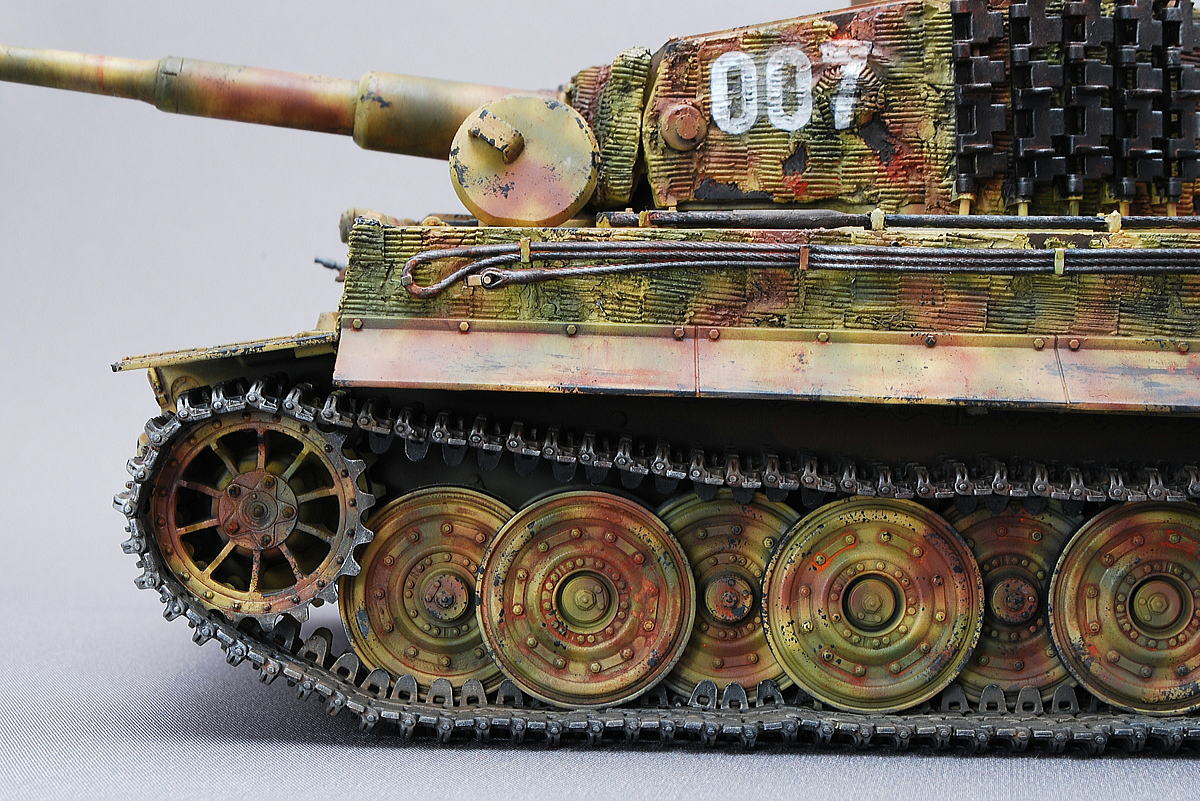 Caterpillar and road wheels are shined and not so muddy.
Caterpillar and road wheels are shined and not so muddy.
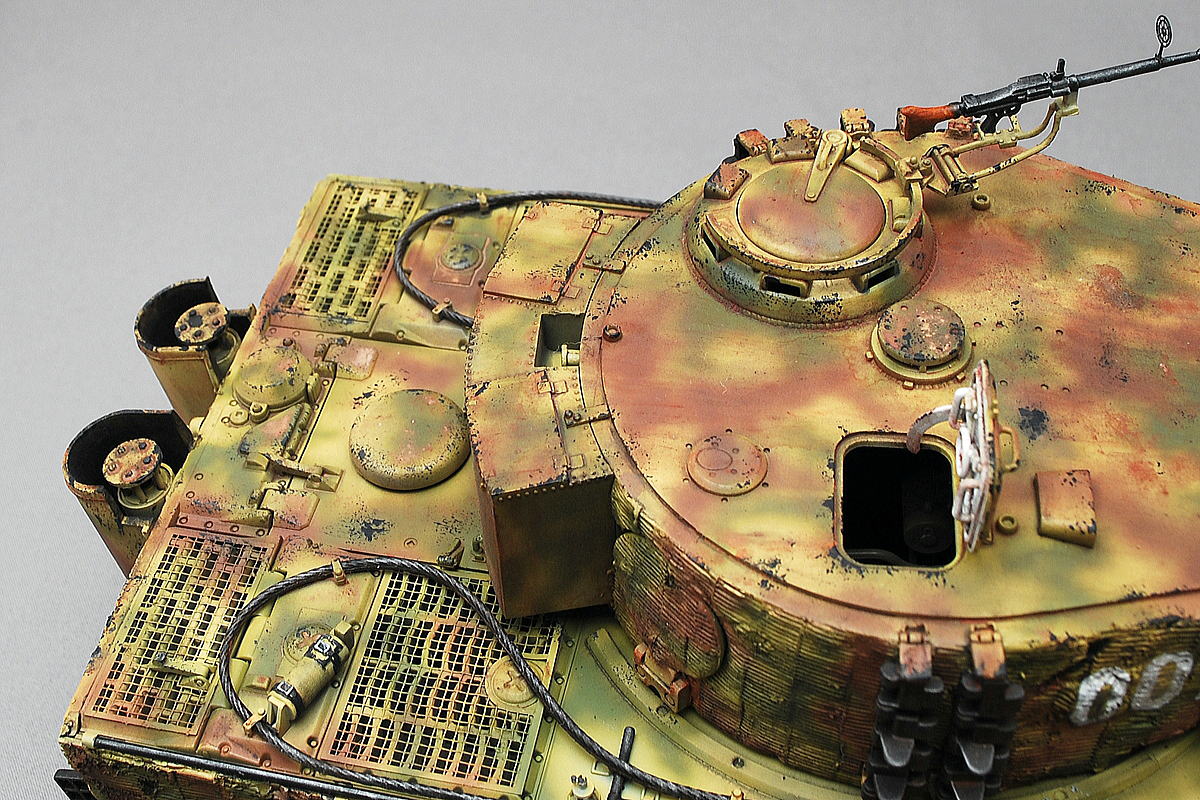 Gepäckkasten(toolbox back on the turret) mold is sharp and nice. I painted the inside of the muffler covers dark brown.
Gepäckkasten(toolbox back on the turret) mold is sharp and nice. I painted the inside of the muffler covers dark brown.
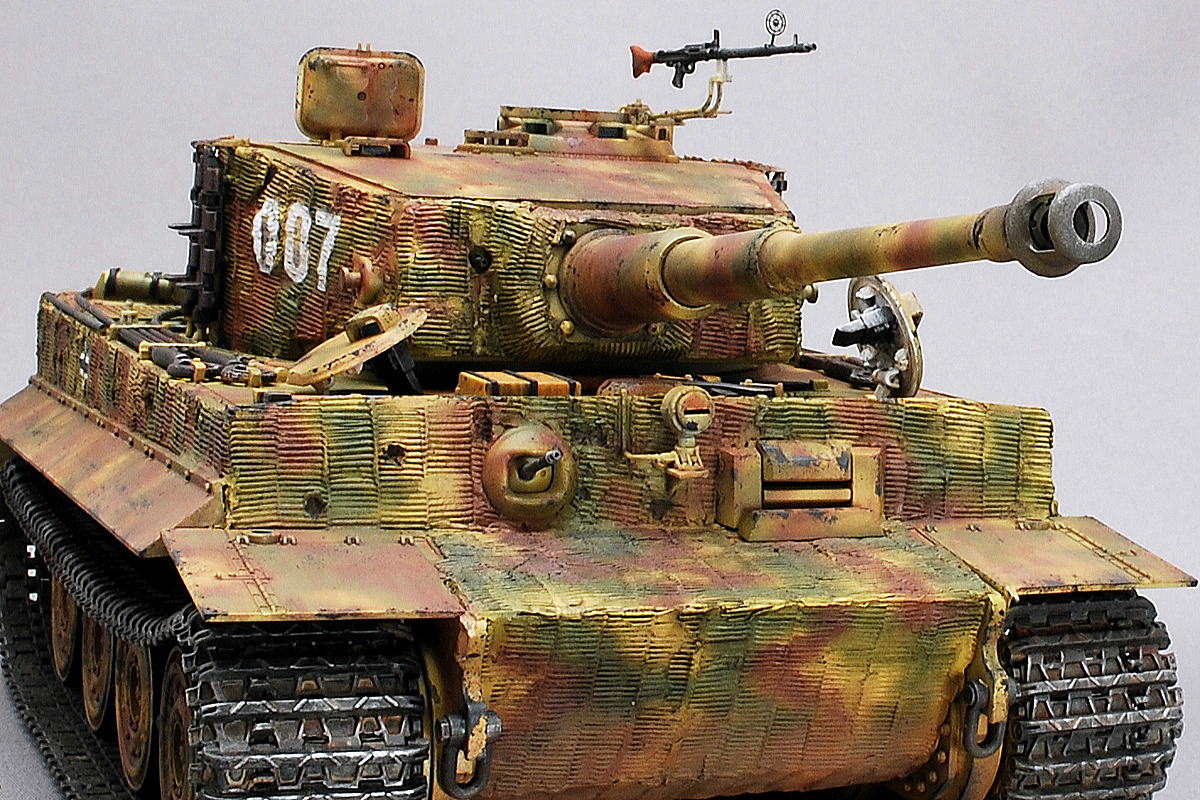 The highly explosive blast-off burned the muzzle. I blew in dark brown and dry brushing in silver.
The highly explosive blast-off burned the muzzle. I blew in dark brown and dry brushing in silver.
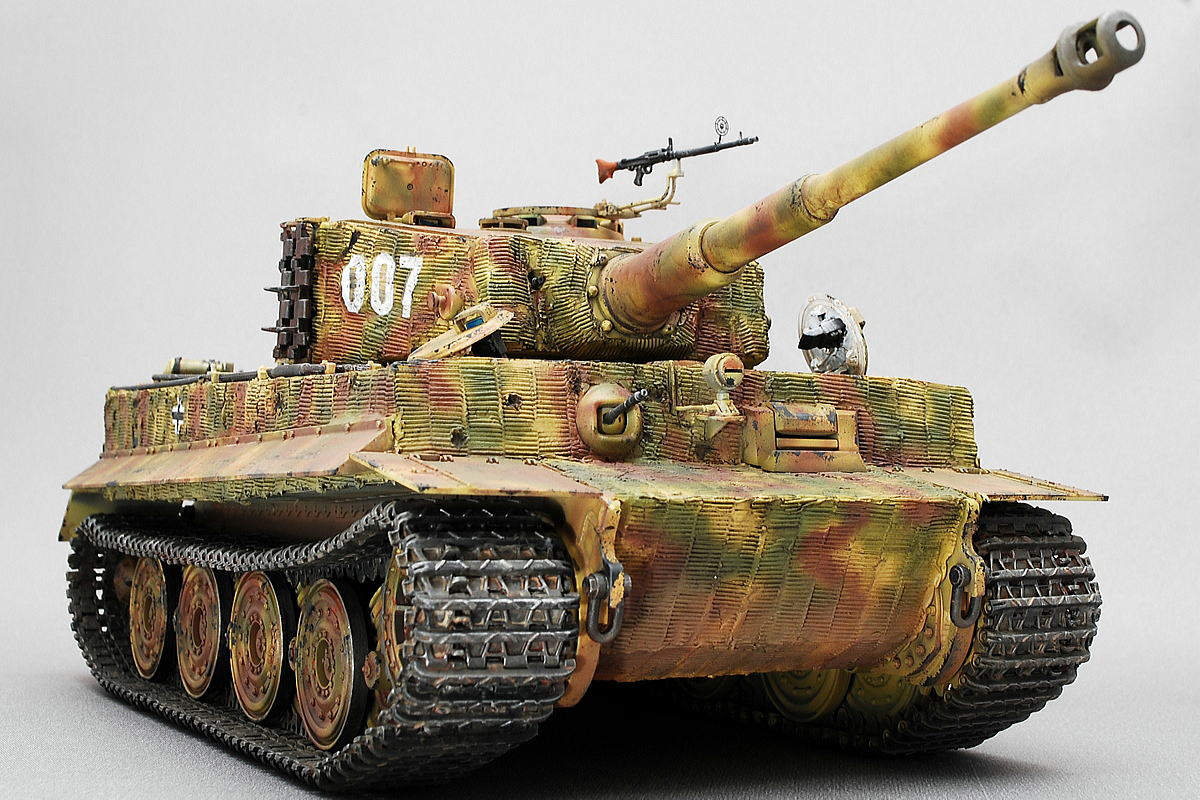 Driver’s and Machine-gunner’s round hatch could be open-closed, but leave open prevents the turret from turning. It will be broken if I handle too much, so the closing position is best. Periscope glass was painted in blue; I suppose green or blue, both OK.
Driver’s and Machine-gunner’s round hatch could be open-closed, but leave open prevents the turret from turning. It will be broken if I handle too much, so the closing position is best. Periscope glass was painted in blue; I suppose green or blue, both OK.
 Speaking of the 101st SS Heavy tank battalion, the battalion commander was the famous Michael Wittmann around that time. He was one of the excellent tank commanders during WWII. Tank number 007 seemed to be his boarding tank. He was killed in action by an attack of the Sherman firefly in the fight of Villers-Bocage on 8th August 1944.
Speaking of the 101st SS Heavy tank battalion, the battalion commander was the famous Michael Wittmann around that time. He was one of the excellent tank commanders during WWII. Tank number 007 seemed to be his boarding tank. He was killed in action by an attack of the Sherman firefly in the fight of Villers-Bocage on 8th August 1944.
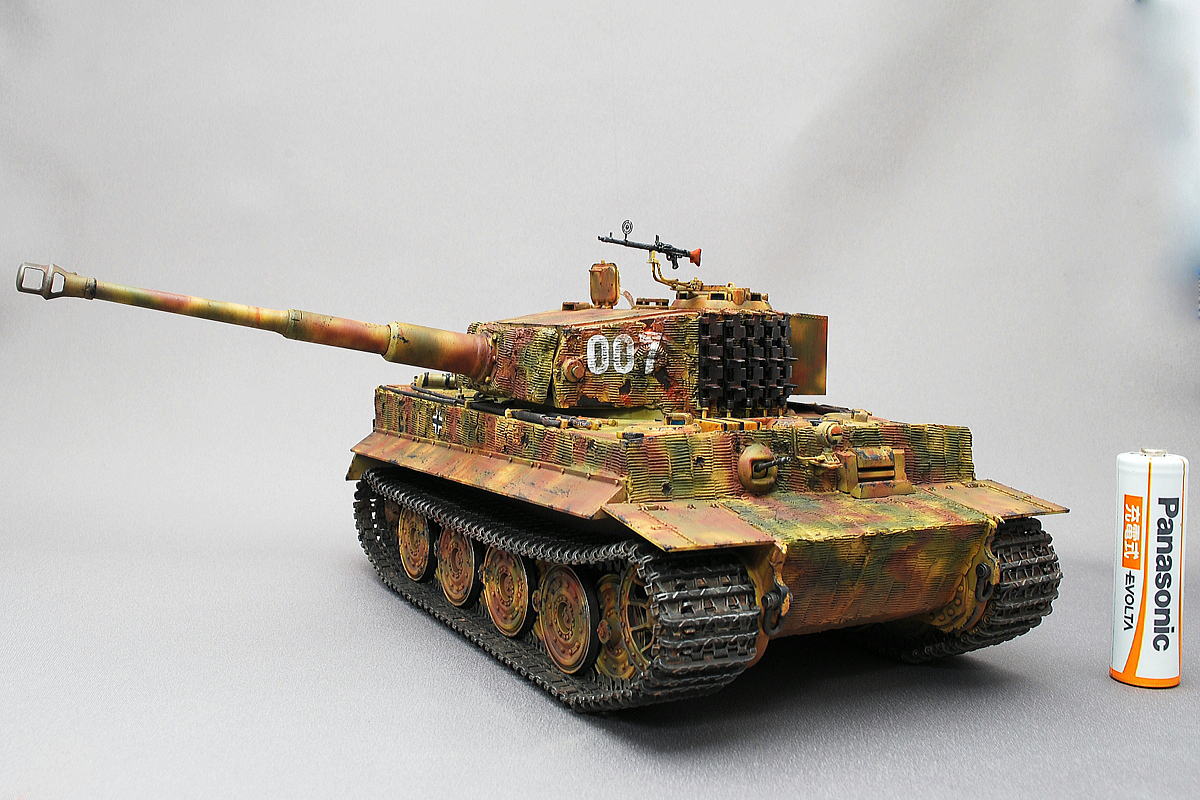 The Zimmerit Coating was challenging but enjoyable. I wonder if it’s improved compared to the Tiger I made. I think it’s cooler than before; I had strong washing but modest weathering.
The Zimmerit Coating was challenging but enjoyable. I wonder if it’s improved compared to the Tiger I made. I think it’s cooler than before; I had strong washing but modest weathering.
(07-March-2015)



コメント